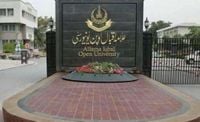In an age where global interactions are becoming increasingly vital, language education is taking center stage as a powerful tool for fostering international cooperation and cultural exchange. Recently, several initiatives across various countries have underscored the importance of acquiring language skills to build bridges between nations.
Nikolay Kukharenko, director of the Confucius Institute at Blagoveshchensk State Pedagogical University (BSPU) in Russia, has been actively promoting Chinese language education for 18 years. He reports a remarkable increase in enrollment, with student numbers skyrocketing from 70 in 2007 to a staggering 450 in 2025. This growth can be attributed to several key initiatives, including a mandate from Amur Oblast Governor Vasily Orlov in 2022, which called for the introduction of Chinese language courses in all schools within Blagoveshchensk.
"I believe this practice will expand to other cities in the Amur Oblast," Kukharenko stated, reflecting on the burgeoning interest in Chinese language and culture. He highlighted the fruitful partnership between BSPU and Heihe University in Heilongjiang Province, dating back to 1989, which serves as a model for other academic collaborations.
Currently, BSPU accommodates 724 Chinese students through various educational programs, drawn by the university's strong academics and its proximity to China. Looking ahead, Kukharenko hopes to expand the presence of Confucius Institute branches throughout the region, noting already the opening of a center in Belogorsk, the second-largest city in the area.
In Islamabad, the Allama Iqbal Open University (AIOU) has also joined the movement to promote language learning. Starting April 14, 2025, AIOU will launch a three-month, face-to-face Russian language course, under the supervision of an experienced instructor. Classes will be held three days a week, catering to students with the option of morning or afternoon sessions. The last date for enrollment is set for April 10, giving interested candidates time to register.
AIOU’s Vice Chancellor, Professor Dr. Nasir Mahmood, is enthusiastic about offering students valuable global education and employment opportunities. This course will be part of a larger framework of language education at AIOU, which already includes programs in Turkish, Chinese, and Japanese. The initiative will be carried out in collaboration with the Russian Federation’s Center for International Cooperation and the Ministry of Education.
Such educational advancements are not limited to classroom learning. The realm of artificial intelligence (AI) is also seeing significant developments in linguistic diversity advocacy. At the Artificial Intelligence Action Summit in Paris on February 10, 2025, Google CEO Sundar Pichai announced that the technology giant had added over 110 new languages to Google Translate, which are now spoken by half a billion people globally. This increased the total number of supported languages to 249, including 60 African languages.
For advocates of linguistic diversity, this announcement signified a significant win after two years of advocacy spearheaded by Joseph Nkalwo Ngoula, a digital policy advisor at the UN mission of the International Organisation of La Francophonie. Ngoula noted, "It shows the message is getting through and tech companies are listening," a sentiment that echoes the collective effort of many international organizations aiming to bridge the linguistic gap in AI.
However, challenges persist. Despite the progress made, a troubling disparity exists in AI’s responsiveness to non-English languages. Ngoula remarked, "The volume of available information in English is much greater, but it’s also more up to date." This gap highlights how AI’s initial training predominantly relied on English, often resulting in superficial responses when queries are presented in other languages.
This systemic bias affects not only the accuracy of the information retrieved but can also lead to AI hallucinations—false, misleading content generated by algorithms. AI models rely on the robustness of data in a given language; without sufficient training data, language features may be misrepresented, or entire queries misunderstood. The repercussions can be felt by speakers of languages that do not possess extensive digital representation.
Cultural nuances often vanish in translation as well, hampering the essence of what makes languages unique. Ngoula pointed out that in places like Cameroon, where diverse languages and dialects co-exist, using AI in everyday communication can lead to a loss of authenticity. Expressions from languages like Camfranglais—a blend of French, English, Pidgin, and local dialects—can leave AI models baffled.
In response to these ongoing challenges, the UN Global Digital Compact—a framework adopted at the UN Summit for the Future in September 2024—was established to prioritize linguistic diversity and inclusion in digital technologies like AI. Pichai’s commitment to developing AI for 1,000 of the world’s most spoken languages illustrates a shifting sentiment toward inclusivity.
To conclude, the recent advancements in language education, whether through structured courses in institutions like BSPU and AIOU or the push for linguistic diversity in AI, highlight an essential shift toward building cultural ties and understanding across borders. In an increasingly interconnected world, promoting knowledge of languages becomes vital not only for individual success but for fostering a more inclusive global society.



